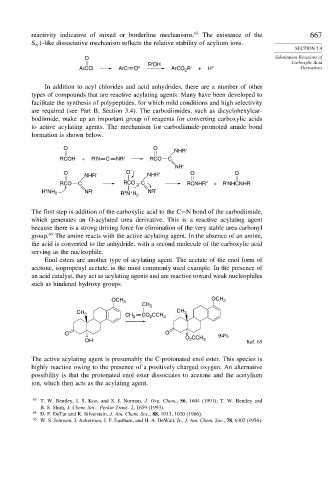Page 685 - Advanced Organic Chemistry Part A - Structure and Mechanisms, 5th ed (2007) - Carey _ Sundberg
P. 685
reactivity indicative of mixed or borderline mechanisms. 63 The existence of the 667
S 1-like dissociative mechanism reflects the relative stability of acylium ions.
N
SECTION 7.4
O Substitution Reactions of
R'OH Carboxylic Acid
ArCCl ArC O + ArCO R' + H + Derivatives
2
In addition to acyl chlorides and acid anhydrides, there are a number of other
types of compounds that are reactive acylating agents. Many have been developed to
facilitate the synthesis of polypeptides, for which mild conditions and high selectivity
are required (see Part B, Section 3.4). The carbodiimides, such as dicyclohexylcar-
bodiimide, make up an important group of reagents for converting carboxylic acids
to active acylating agents. The mechanism for carbodiimide-promoted amide bond
formation is shown below.
O O
NHR'
RCOH + R'N C NR' RCO C
NR'
O O – O O
NHR' NHR'
RCO C RCO C RCNHR" + R'NHCNHR'
R"NH 2 NR' R"N H 2 NR'
+
The first step is addition of the carboxylic acid to the C=N bond of the carbodiimide,
which generates an O-acylated urea derivative. This is a reactive acylating agent
because there is a strong driving force for elimination of the very stable urea carbonyl
64
group. The amine reacts with the active acylating agent. In the absence of an amine,
the acid is converted to the anhydride, with a second molecule of the carboxylic acid
serving as the nucleophile.
Enol esters are another type of acylating agent. The acetate of the enol form of
acetone, isopropenyl acetate, is the most commonly used example. In the presence of
an acid catalyst, they act as acylating agents and are reactive toward weak nucleophiles
such as hindered hydroxy groups.
OCH 3 OCH 3
CH 3
CH 3 CH 2 CO CCH 3 CH 3
2
O O 94%
O CCH
OH 2 3 Ref. 65
The active acylating agent is presumably the C-protonated enol ester. This species is
highly reactive owing to the presence of a positively charged oxygen. An alternative
possibility is that the protonated enol ester dissociates to acetone and the acetylium
ion, which then acts as the acylating agent.
63 T. W. Bentley, I. S. Koo, and S. J. Norman, J. Org. Chem., 56, 1604 (1991); T. W. Bentley and
B. S. Shim, J. Chem. Soc., Perkin Trans. 2, 1659 (1993).
64 D. F. DeTar and R. Silverstein, J. Am. Chem. Soc., 88, 1013, 1020 (1966).
65
W. S. Johnson, J. Ackerman, J. F. Eastham, and H. A. DeWalt, Jr., J. Am. Chem. Soc., 78, 6302 (1956).

